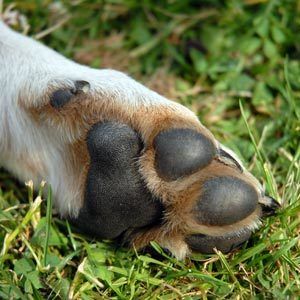“This post contains affiliate links, and I will be compensated if you make a purchase after clicking on my links.”
Caring for your dog’s paw pads is a normal part of taking good care of your loved dog. As he or she engages in physical activity cuts and abrasions can be expected, so a weekly examination is in order. Unlike humans, dogs are more immune to feeling pain or complaining about it, so we should be more sensitive towards them and check if there is something we need to have looked at by your vet.
Caring for Your Dog’s Paw Pads
Some dogs can endure paw pad injuries and still be able to run and walk. However, there is a way to check if your dog’s paw pads are infected or injured – by checking out how much your dog licks them. Excessive licking can be a sign that there is something wrong with his paw pads.

When your dog walks on warm surfaces such as concrete, under the blazing sun, he actually risks getting his paw pads injured or sore. So if you are taking your dog for a walk, make sure that it is the time of the day when the sun is not glaring that much. Early morning and evening times are the best times to walk your dog. Also, it can depend on your dog’s ability to adapt and adjust to the kind of weather his breed is naturally best suited for. Some dogs can do better in the heat while others are accustomed to the cold. This is another special quality of dogs – they can endure harsh weather more than ordinary humans can.
With that in mind, you should be responsible in caring for your dog’s paw pads, because a little infection can go a long way. Here are some tips on how to help your dog survive a day without getting paw pad injuries:
- Avoid walking on black pavements because they are usually hotter than a concrete sidewalk when exposed to the sun. However, if black pavement is unavoidable, then try to limit the time that your dog walks on this surface and always keep them moving whenever they are on top of a hot surface. Think of it as running your fingers through a candle and not getting burned – the same is true for dogs as they cross the blazing sidewalks. In short – do not make them stand still or their paw pads will be toasted.
- Walking on sand, especially darker sand can also be excruciating for dogs and their paw pads, because they get hot eventually. You can let your dog walk alongside the shoreline instead, where the cool temperature of the water can heal their sore paw pads. You can also try letting your dog walk along lighter sand.
- Many sharp objects like broken glass and sharp rocks can be at the beach or even in the streets, so it is important that you check your dog’s paw pads from time to time for any cuts or damage to his feet. This is because not all beaches and streets are free of these harmful objects – you have to be vigilant on what your dog walks on.
- Treat any paw pad injury by washing it first, and then drying with a clean towel. Use antiseptic such as betadine, or even natural remedies like Neem Oil or Coconut Oil. Then, wrap it in rolled gauze and bandage it. Rewrap as necessary.
Caring for your dog’s paw pads are our responsibility as dog owners plus your pooch will love you all the more for doing so.
How do you care for your dog’s pads? Please share this article with fellow dog owners.













Laura
Apr 24, 2013 at 12:03 am
Good advise. Thanks.
My Dalmation did have trouble with the snow and ice and was sorta chewing on his feet. His pads looked like they were getting close to splitting. He is a house dog, so isn’t outside In harsh weather longer than need be. Do you have any suggestions?
Ron Miller
Apr 17, 2013 at 5:14 pm
Thanks for that reminder, Susan. One of our previous dogs had a lot of hair growing between the pads, and we had to pay special attention to keeping it trimmed. I had forgotten about that.
Susan
Apr 17, 2013 at 11:46 am
Don’t forget to cut the hair or fur off the bottom of the paw pads. My one dog has fur growing between the pads and it gets about an inch or so long he ends up walking on the fur and pads. Also, keep their toenail trimmed especially for older dogs because it makes them walk differently and it puts pressure on their hips and shoulders.